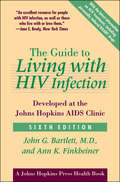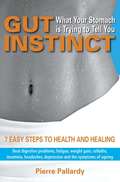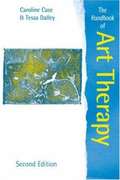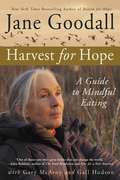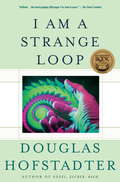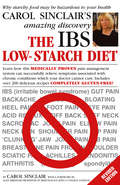- Table View
- List View
Good Practice in Brain Injury Case Management (Good Practice in Health, Social Care and Criminal Justice)
by Jackie ParkerThis book provides a guide to effective case management, outlining all the key issues that professionals working with brain-injured people will need to know, from understanding what brain injury actually is and how it feels to experience it to strategies for rehabilitation, assessing risk and implementing support plans.
The Guide to Living with HIV Infection: Developed at the Johns Hopkins AIDS Clinic (A Johns Hopkins Press Health Book)
by Ann K. Finkbeiner John G. BartlettThe Guide to Living with HIV Infection is the most complete source of medical, emotional, social, and practical advice available for those infected with HIV and their loved ones. Developed at the Johns Hopkins AIDS Clinic, the guide provides essential information for making decisions about treatment and testing in a world transformed by new research and pharmacotherapy.In this thoroughly updated sixth edition, Dr. John Bartlett and Ann K. Finkbeiner address the latest information about risks of transmission, viral mutations that confer drug resistance, and new, rapid, HIV testing. They offer guidelines for Highly Active Antiretroviral Therapy (HAART), a therapy protocol that has dramatically increased life expectancy for HIV-positive people. They describe how to follow HAART and when to change drug regimens, the symptoms of and treatments for HAART side effects, and the costs of and insurance coverage for HAART. They also outline the possibilities for a diagnosis of "no detectable virus."Accompanied by updated references and resources, the sixth edition of The Guide to Living with HIV Infection offers new hope for people living with a virus that once left no hope at all.
Gut Instinct: 7 easy steps to health and healing
by Pierre PallardyIn this pioneering book, Gut Instinct, Pierre Pallardy shares his 7-step method of caring for the stomach – the body’s ‘second brain’. It includes guidance on breathing techniques, the importance of eating regularly and slowly, choosing your food wisely, finding an appropriate sport, creating harmony between the two brains, self-massage techniques and abdominal meditation. These steps will help prevent ill-health but many can also be used to treat various illnesses, and advice is given on this where appropriate. Pallardy’s method can achieve spectacular results, yet the steps are straightforward and are workable with today’s hectic lifestyles. The secret to good health is not complicated – it is already inside you.
The Handbook of Art Therapy (PDF)
by Tessa Dalley Caroline CaseWhat is art therapy? How can art and therapy combine to help individuals understand aspects of their inner life? This new edition of The Handbook of Art Therapy is thoroughly revised and updated and includes new sections on neurobiological research, and a current review of literature and contemporary practice. It provides a comprehensive introduction to the field of art therapy in a variety of different settings. Caroline Case and Tessa Dalley draw on their experience of teaching and practising art therapy, concentrating on what art psychotherapists actually do, where they practice, and how and why art therapy is effective. First-hand accounts of the experience of art therapy from both therapists and clients are used throughout, enriching the discussion of subjects including: the art therapy room art and psychoanalysis art therapy and creativity working with groups in art therapy art therapy with individual patients This straight-forward and highly practical Handbook will be invaluable not only as an introduction to the profession but also as a reference for students of art psychotherapy both during and after their training.
The Handbook of Cannabis Therapeutics: From Bench to Bedside
by Ethan B. Russo Franjo GrotenhermenLearn the facts behind the pharmacology and pharmacokinetics of controversial cannabis therapeuticsThe Handbook of Cannabis Therapeutics: From Bench to Bedside sets aside the condemnation and hysteria of society&’s view of cannabis to concentrate on the medically sound aspects of cannabis therapeutics. The world&’s foremost experts provide a reasoned, thoroughly researched overview of the controversial subject of cannabis, from its history as a medicine through its latest therapeutic uses. The latest studies on the botany, history, biochemistry, pharmacology, toxicology, clinical use for various illnesses such as AIDS, epilepsy, and multiple sclerosis, and side effects of marijuana are all examined and discussed in depth. This comprehensive resource is a compendium of articles from the Journal of Cannabis Therapeutics-with additional contemporary commentary. It presents startling research that explores and supports the medicinal value of cannabis use and its derivatives as a valid therapeutic resource for pain and inflammation, for several illnesses less responsive to other therapies, and even for certain veterinary uses. Cannabinoids such as nabilone, THC, levonantradol, ajulemic acid, dexanabinal, and others are extensively described, with a review of new indications for cannabinoid pharmaceuticals. The book is carefully referenced to encourage your examination of previous studies and provides tables and figures to enhance understanding of information.The Handbook of Cannabis Therapeutics discusses: the uses of cannabis in Arabic, Greek, Roman, and early English medicines absorption rates pharmacokinetics pharmacodynamics separate extracts versus the use of cannabis in its entirety the therapeutic value of the endocannabinoid system cannabinoids and newborn feeding a comparison of smoking versus oral preparations clinical research data on eating cannabis therapeutic uses as appetite stimulant treatments in obstetrics and gynecology medicinal treatments used in Jamaica the use of cannabis in the treatment of multiple sclerosis the benefits versus the adverse side effects of cannabis useThe Handbook of Cannabis Therapeutics is a reference work certain to become crucial to physicians, psychologists, researchers, biochemists, graduate students, and interested members of the public.
The Handbook of Cannabis Therapeutics: From Bench to Bedside
by Ethan B. Russo Franjo GrotenhermenLearn the facts behind the pharmacology and pharmacokinetics of controversial cannabis therapeuticsThe Handbook of Cannabis Therapeutics: From Bench to Bedside sets aside the condemnation and hysteria of society&’s view of cannabis to concentrate on the medically sound aspects of cannabis therapeutics. The world&’s foremost experts provide a reasoned, thoroughly researched overview of the controversial subject of cannabis, from its history as a medicine through its latest therapeutic uses. The latest studies on the botany, history, biochemistry, pharmacology, toxicology, clinical use for various illnesses such as AIDS, epilepsy, and multiple sclerosis, and side effects of marijuana are all examined and discussed in depth. This comprehensive resource is a compendium of articles from the Journal of Cannabis Therapeutics-with additional contemporary commentary. It presents startling research that explores and supports the medicinal value of cannabis use and its derivatives as a valid therapeutic resource for pain and inflammation, for several illnesses less responsive to other therapies, and even for certain veterinary uses. Cannabinoids such as nabilone, THC, levonantradol, ajulemic acid, dexanabinal, and others are extensively described, with a review of new indications for cannabinoid pharmaceuticals. The book is carefully referenced to encourage your examination of previous studies and provides tables and figures to enhance understanding of information.The Handbook of Cannabis Therapeutics discusses: the uses of cannabis in Arabic, Greek, Roman, and early English medicines absorption rates pharmacokinetics pharmacodynamics separate extracts versus the use of cannabis in its entirety the therapeutic value of the endocannabinoid system cannabinoids and newborn feeding a comparison of smoking versus oral preparations clinical research data on eating cannabis therapeutic uses as appetite stimulant treatments in obstetrics and gynecology medicinal treatments used in Jamaica the use of cannabis in the treatment of multiple sclerosis the benefits versus the adverse side effects of cannabis useThe Handbook of Cannabis Therapeutics is a reference work certain to become crucial to physicians, psychologists, researchers, biochemists, graduate students, and interested members of the public.
Harvest for Hope: A Guide to Mindful Eating
by Jane Goodall Gail Hudson Gary McAvoyFrom world-renowned scientist Jane Goodall, as seen in the new National Geographic documentary Jane, comes a provocative look into the ways we can positively impact the world by changing our eating habits. "One of those rare, truly great books that can change the world." - John Robbins, author of The Food RevolutionThe renowned scientist who fundamentally changed the way we view primates and our relationship with the animal kingdom now turns her attention to an incredibly important and deeply personal issue-taking a stand for a more sustainable world. In this provocative and encouraging book, Jane Goodall sounds a clarion call to Western society, urging us to take a hard look at the food we produce and consume-and showing us how easy it is to create positive change.Offering her hopeful, but stirring vision, Goodall argues convincingly that each individual can make a difference. She offers simple strategies each of us can employ to foster a sustainable society. Brilliant, empowering, and irrepressibly optimistic, HARVEST FOR HOPE is one of the most crucial works of our age. If we follow Goodall's sound advice, we just might save ourselves before it's too late.
Health Information on the Internet: A Study of Providers, Quality, and Users (Non-ser.)
by Rowena CullenThe accessibility of health information on the Internet has revolutionized access to clinical information for health practitioners and patients. This access to information has the potential to make a major contribution to health care. However, the effective use of this accessibility depends on an understanding of all the issues involved, from the underlying technologies and economic pressures, to questions of how best to manage quality and privacy, how people seek and use information, and what the barriers to its use are. Cullen's book also examines the extent of health information on the Internet, the providers of websites and their content, and outlines the nature of the paradigm shift affecting knowledge in the health sector.
Herbal Medicines in Pregnancy and Lactation: An Evidence-Based Approach
by Edward Mills Jean-Jacques Dugoua Dan Perri Gideon KorenJust as with prescription drugs, natural health products can present substantial risks and prompt the same areas of concern. Although some of these effects may be life-threatening, current literature on these important issues is scant.With the use of natural health products on the rise, physicians require quality evidence with which to make evi
Herbal Supplements-Drug Interactions: Scientific and Regulatory Perspectives
by Y. W. Francis Lam Shiew-Mei Huang Stephen D. HallThe international popularity of herbal remedies has recently outpaced quality information on the utilization and dosing of these compounds. This book fills a void in the literature by offering an authoritative overview of the mechanisms of herbal remedies and their impact on standard medications. It offers a practical approach that focuses not only
History of the Concept of Mind: Volume 2: The Heterodox and Occult Tradition
by Paul S. MacdonaldExploring the 'roads less travelled', MacDonald continues his monumental essay in the history of ideas. The history of heterodox ideas about the concept of mind takes the reader from the earliest records about human nature in Ancient Egypt, the Ancient Near East, and the Zoroastrian religion, through the secret teachings in the Hermetic and Gnostic scriptures, and into the transformation of ideas about the mind, soul and spirit in the late antique and early medieval epochs. These transitions include discussion of the influence of Central Asian shamanism, Manichean ideas about the soul in light and darkness, and Neoplatonic theurgy, 'working-on-god-within'. Sections on the medieval period are concerned with the rediscovery of magical practices and occult doctrines from Roger Bacon to Francis Bacon, the adaptation of Neoplatonic and esoteric ideas in the medieval Christian mystics, and the survival of these ideas mixed with natural science in the works of von Helmont, Leibniz and Goethe. The book concludes with an investigation of the many forms of dualism in accounts of the human mind and soul, and the concept of dual-life which underpins our aspiration to understand how humans could have an immortal nature like the gods.
History of the Concept of Mind: Volume 2: The Heterodox and Occult Tradition
by Paul S. MacdonaldExploring the 'roads less travelled', MacDonald continues his monumental essay in the history of ideas. The history of heterodox ideas about the concept of mind takes the reader from the earliest records about human nature in Ancient Egypt, the Ancient Near East, and the Zoroastrian religion, through the secret teachings in the Hermetic and Gnostic scriptures, and into the transformation of ideas about the mind, soul and spirit in the late antique and early medieval epochs. These transitions include discussion of the influence of Central Asian shamanism, Manichean ideas about the soul in light and darkness, and Neoplatonic theurgy, 'working-on-god-within'. Sections on the medieval period are concerned with the rediscovery of magical practices and occult doctrines from Roger Bacon to Francis Bacon, the adaptation of Neoplatonic and esoteric ideas in the medieval Christian mystics, and the survival of these ideas mixed with natural science in the works of von Helmont, Leibniz and Goethe. The book concludes with an investigation of the many forms of dualism in accounts of the human mind and soul, and the concept of dual-life which underpins our aspiration to understand how humans could have an immortal nature like the gods.
History of the Concept of Mind: Volume 1: Speculations About Soul, Mind and Spirit from Homer to Hume
by PaulS. MacdonaldIn the 20th century theorists of mind were almost exclusively concerned with various versions of the materialist thesis, but prior to current debates accounts of soul and mind reveal an extraordinary richness and complexity which bear careful and impartial investigation. This book is the first single-authored, comprehensive work to examine the historical, linguistic and conceptual issues involved in exploring the basic features of the human mind - from its most remote origins to the beginning of the modern period. MacDonald traces the development of an armature of psychical concepts from the Old Testament and Homer's works to the 18th century advocacy of an empirical science of the mind. Along the way, detailed attention is paid to the Presocratics, Plato, Aristotle, the Stoics and Epicurus, before turning to look at the New Testament, Neoplatonism, Augustine, Medieval Islam, Aquinas and Dante. Treatment of Renaissance theories is followed by an unusual (perhaps unique) chapter on the words "soul" and "mind" in English literature from Chaucer to Shakespeare; the story then rejoins the mainstream with analyses of Descartes, Spinoza, Leibniz, Hobbes, Locke, Berkeley, and Hume. Chapter-focused bibliographies.
History of the Concept of Mind: Volume 1: Speculations About Soul, Mind and Spirit from Homer to Hume
by PaulS. MacdonaldIn the 20th century theorists of mind were almost exclusively concerned with various versions of the materialist thesis, but prior to current debates accounts of soul and mind reveal an extraordinary richness and complexity which bear careful and impartial investigation. This book is the first single-authored, comprehensive work to examine the historical, linguistic and conceptual issues involved in exploring the basic features of the human mind - from its most remote origins to the beginning of the modern period. MacDonald traces the development of an armature of psychical concepts from the Old Testament and Homer's works to the 18th century advocacy of an empirical science of the mind. Along the way, detailed attention is paid to the Presocratics, Plato, Aristotle, the Stoics and Epicurus, before turning to look at the New Testament, Neoplatonism, Augustine, Medieval Islam, Aquinas and Dante. Treatment of Renaissance theories is followed by an unusual (perhaps unique) chapter on the words "soul" and "mind" in English literature from Chaucer to Shakespeare; the story then rejoins the mainstream with analyses of Descartes, Spinoza, Leibniz, Hobbes, Locke, Berkeley, and Hume. Chapter-focused bibliographies.
Holism and Complementary Medicine: Origins and principles
by Vincent Di StefanoThe return to holistic therapies is one of the most important developments in health over the past two decades. With preventative medicine being taken more seriously by conventional health practitioners, and the increasing popularity of natural and complementary therapies among consumers, it is clear that a holistic approach will be integral to health care in the future. Holism and Complementary Medicine offers a systematic overview of traditional healing practices, the development of the Western biomedical model from the ancient Egyptians and Greeks to the present, and the holistic philosophy which is the basis of complementary and alternative medicine in the West. The book explores the differences between holistic and conventional biomedical traditions and approaches, acknowledging the strengths of each. It also addresses key practice issues, examining the role holistic principles have to play in today's health system and explaining their place in the therapeutic relationship. Holism and Complementary Medicine is an accessible guide for students, practitioners and anyone interested in the origins and core principles of natural therapies.'This scholarly exploration of the conceptual evolution of holistic medicine is a fascinating read. Di Stefano is to be congratulated for his articulate insights into healing relationships and how our health paradigms enhance or inhibit our understanding of health and disease.' - Joseph Pizzorno, ND, President Emeritus, Bastyr University'This is a magnificent read for students of natural and complementary medicine, as well as health professionals and lay public who have often wondered where the movement towards holism in medicine began and is headed.' - Paul Orrock, Head of the School of Natural and Complementary Medicine, Southern Cross University'. . . brings together many threads that link the health of body, mind and society, drawing richly from a larger corpus of intellectual inquiry into history, philosophy, and human endeavor, including clinical medicine.' - Bruce Barrett MD PhD, Assistant Professor of Family Medicine, University of Wisconsin, Madison
Holism and Complementary Medicine: Origins and principles
by Vincent Di StefanoThe return to holistic therapies is one of the most important developments in health over the past two decades. With preventative medicine being taken more seriously by conventional health practitioners, and the increasing popularity of natural and complementary therapies among consumers, it is clear that a holistic approach will be integral to health care in the future. Holism and Complementary Medicine offers a systematic overview of traditional healing practices, the development of the Western biomedical model from the ancient Egyptians and Greeks to the present, and the holistic philosophy which is the basis of complementary and alternative medicine in the West. The book explores the differences between holistic and conventional biomedical traditions and approaches, acknowledging the strengths of each. It also addresses key practice issues, examining the role holistic principles have to play in today's health system and explaining their place in the therapeutic relationship. Holism and Complementary Medicine is an accessible guide for students, practitioners and anyone interested in the origins and core principles of natural therapies.'This scholarly exploration of the conceptual evolution of holistic medicine is a fascinating read. Di Stefano is to be congratulated for his articulate insights into healing relationships and how our health paradigms enhance or inhibit our understanding of health and disease.' - Joseph Pizzorno, ND, President Emeritus, Bastyr University'This is a magnificent read for students of natural and complementary medicine, as well as health professionals and lay public who have often wondered where the movement towards holism in medicine began and is headed.' - Paul Orrock, Head of the School of Natural and Complementary Medicine, Southern Cross University'. . . brings together many threads that link the health of body, mind and society, drawing richly from a larger corpus of intellectual inquiry into history, philosophy, and human endeavor, including clinical medicine.' - Bruce Barrett MD PhD, Assistant Professor of Family Medicine, University of Wisconsin, Madison
Home with God: In A Life That Never Ends
by Neale Donald WalschNothing has frightened or fascinated us more than the experience that we call 'death'. Now, in what very well could be the most profound of all his CONVERSATIONS WITH GOD books, bestselling Mobius author Neale Donald Walsch asks the questions that we have all wanted to ask, and receives answers we have all been waiting for, in this deeply moving and highly personal dialogue with Deity. HOME WITH GOD is the definitive spiritual work on death and dying, offering new insights, deep wisdom and peace of mind, for the terminally ill, family members of the dying, hospital and medical professionals, members of the clergy, and everyone encountering death. HOME WITH GOD logically completes Neale Donald Walsch's dialogue with God, exploring the process by which we end our lives here on earth and begin our so-called After Life experience. A book of comfort, hope and surprising revelation, HOME WITH GOD is an astonishing, deeply healing, and reassuring spiritual classic.
I Am a Strange Loop: I Am A Strange Loop
by Douglas R. HofstadterOne of our greatest philosophers and scientists of the mind asks, where does the self come from--and how our selves can exist in the minds of others. Can thought arise out of matter? Can self, soul, consciousness, "I" arise out of mere matter? If it cannot, then how can you or I be here? I Am a Strange Loop argues that the key to understanding selves and consciousness is the "strange loop"-a special kind of abstract feedback loop inhabiting our brains. The most central and complex symbol in your brain is the one called "I." The "I" is the nexus in our brain, one of many symbols seeming to have free will and to have gained the paradoxical ability to push particles around, rather than the reverse. How can a mysterious abstraction be real-or is our "I" merely a convenient fiction? Does an "I" exert genuine power over the particles in our brain, or is it helplessly pushed around by the laws of physics? These are the mysteries tackled in I Am a Strange Loop, Douglas Hofstadter's first book-length journey into philosophy since Gödel, Escher, Bach. Compulsively readable and endlessly thought-provoking, this is a moving and profound inquiry into the nature of mind.
I Had the Strangest Dream...: The Dreamer's Dictionary for the 21st Century
by Kelly Sullivan WaldenIn the mega-selling tradition of The Dreamer&’s Dictionary comes a comprehensive, contemporary guide to understanding dreams and the unconscious mind. With over 3,500 symbols and a 7-step guide to applying their definitions to one&’s life, this is the ultimate guide for today&’s dreamer.It's a double-caf low-fat Frappuccino-kind of world, and all that bustle doesn't stop just because it's time for bed. While you sleep, your mind is busy going over everything you've experienced during the day. Now, with the only dream book that interprets both classic and new twenty-first century symbols - everything from speed dating and Botox to text messages and iPods - you can tap into your unconscious with the turn of a page. Discover the messages hidden in your dreams, your hopes, your fears, your unrealized strengths and potential. You'll learn how to recognize life-altering opportunities and become the person you've always dreamed of being.
IBS For Dummies (For Dummies Ser.)
by Carolyn Dean L. Christine WheelerSpot the triggers and handle IBS at home or work Get control of your symptoms and improve your quality of life Are you or a loved one suffering from IBS? This plain-English, reassuring guide explains all aspects of this frustrating condition and helps you find the right doctor and treatment plan. You get up-to-date information on the latest tests, healthy nutrition guidelines, diet and exercise plans, and the newest medicines and therapies to bring you much-needed relief. Discover how to * Get an accurate diagnosis * Recognize the warning signs * Reduce your stress * Weigh treatment pros and cons * Adopt an IBS-friendly diet * Help children with IBS
IBS For Dummies
by Carolyn Dean L. Christine WheelerSpot the triggers and handle IBS at home or work Get control of your symptoms and improve your quality of life Are you or a loved one suffering from IBS? This plain-English, reassuring guide explains all aspects of this frustrating condition and helps you find the right doctor and treatment plan. You get up-to-date information on the latest tests, healthy nutrition guidelines, diet and exercise plans, and the newest medicines and therapies to bring you much-needed relief. Discover how to * Get an accurate diagnosis * Recognize the warning signs * Reduce your stress * Weigh treatment pros and cons * Adopt an IBS-friendly diet * Help children with IBS
The IBS Low-Starch Diet: Why starchy food may be hazardous to your health
by Carol SinclairTwenty per cent of the UK population - 12 million people - suffer IBS-related symptoms, but they may be unaware that the simple elimination of starch from their diet can bring dramatic relief from pain and discomfort.In this revised edition, Carol Sinclair, a sufferer who has successfully overcome IBS and arthritic pain, brings you a revolutionary programme for a pain-free future. This practical guide will help millions to reduce their arthritic symptoms, whose pain to date has been relieved only by regular medication, with sometimes dangerous side effects.The diet shows that a gradual reduction of starch in one's diet can dramatically reduce pain in days, to a point where drug usage is reduced and, in some cases, eliminated completely. Details of the discovery - along with case histories and a practical guide - make Carol Sinclair's book a first in the world.The IBS Low-Starch Diet also contains over 200 delicious starch- and gluten-free recipes, along with a comprehensive guide to eating out.
IBS Relief: A Complete Approach to Managing Irritable Bowel Syndrome
by Dawn Burstall T. Michael Vallis Geoffrey K. TurnbullTake control of IBS so IBS doesn't take control of your life IBS Relief, Second Edition is an extensively updated, hands-on guide to help you manage your symptoms and limit the frequency, intensity, and duration of irritable bowel syndrome (IBS) episodes. Written by a doctor, a dietitian, and a psychologist, this guide gives you a multidisciplinary approach encompassing every proven strategy for managing IBS, including new drug therapies and stress management techniques. This book won't confuse you with medical terminology--IBS is confounding enough. Instead, the book contains questionnaires, lists, diaries, stress and food tolerance tests, and other tools to help you determine the pattern of your symptoms, identify triggers, and take appropriate action. You'll learn how to manage your problem based on your specific symptoms. Approaches include: * A three-step process for managing irritable bowel through healthy eating * Recommended diet adjustments for the six most common IBS symptoms * Three stress-management strategies, including specific techniques for calming the body, calming the mind, and confronting stress * Three steps to controlling pain This book gives you the tools, the techniques, and the information you need to make specific lifestyle and diet changes that can bring real relief.
Immanent Realism: An Introduction to Brentano (Synthese Library #333)
by Liliana AlbertazziIn many respects, Brentano conducted pioneering analyses of problems that are currently in the focus of cognitive science and artificial intelligence: from the problem of reference to that of representation, from the problem of categorial classification to ontology and the cognitive analysis of natural language. Brentano, in fact, dealt with and wrote on questions concerning the auditory stream (temporal apprehension), visual perception (continua, point of view, three-dimensional construction of phenomenal objects), intentionality, imagery, and conceptual space, considering these pertaining to a metaphysical enquiry. Moreover, Brentano displayed clear awareness of the complexity of problems and of the interrelations among different areas of inquiry. From this point of view, his theory, however complex, offers elements for the treatment of problems currently under investigation. Brentano's work is an antidote against physicalism and logicism, which dominated the 20th century epistemology, and as such appears to be a good philosophy candidate for cognitive science."A set of knotty questions are implied in the very title of Brentano's work "Psychology from an empirical standpoint". To solve them, Albertazzi guides us systematically through Brentano's life and works, investigating into the inherent complexity of both his view of mental life and the related methodology. In so doing, she discloses a number of threads into the open texture of modern philosophy of mind." Lia Formigari, Ordinary professor of Philosophy of Language, La Sapienza, Rome, Italy
The Incarnation of Ahriman: The Embodiment of Evil on Earth
by Rudolf SteinerWhile we know of Ahriman from Persian mythology, Rudolf Steiner spoke of him as an actual, living spiritual entity. This being, he said, works to embed people firmly into physicality, encouraging dull, materialistic attitudes and a philistine, dry intellect. In these extraordinary lectures Steiner, in rare prophetic mode, talks about an actual incarnation of Ahriman on the earth and the potential consequences. Just as Christ incarnated in a physical body, so would Ahriman incarnate in the Western world - before 'a part' of the third millennium had passed. Steiner places this incarnation in the context of a 'cosmic triad' - Lucifer, Christ and Ahriman. Ahriman will incarnate as a counterpoint to the physical incarnation of Lucifer in the East in the third millennium BC, with the incarnation of Jesus Christ in Palestine as the balancing point between the two. Over the period during which Steiner developed anthroposophy - a speaking career that spanned two decades and more than six thousand lectures - he referred to the idea of Ahriman's incarnation only six times. These six lectures, together with an additional supporting excerpt, are reproduced in their entirety, and under one cover, for the first time.

